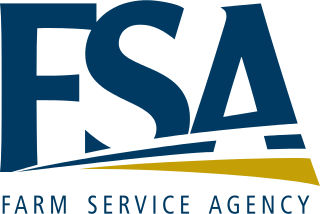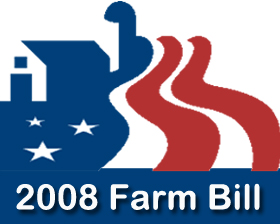
The economy of Mali is based to a large extent upon agriculture, with a mostly rural population engaged in subsistence agriculture.

The Agricultural Adjustment Act (AAA) was a United States federal law of the New Deal era designed to boost agricultural prices by reducing surpluses. The Government bought livestock for slaughter and paid farmers subsidies not to plant on part of their land. The money for these subsidies was generated through an exclusive tax on companies which processed farm products. The Act created a new agency, the Agricultural Adjustment Administration, an agency of the U.S. Department of Agriculture, to oversee the distribution of the subsidies. The Agriculture Marketing Act, which established the Federal Farm Board in 1929, was seen as a strong precursor to this act. The AAA, along with other New Deal programs, represented the federal government's first substantial effort to address economic welfare in the United States.

The Farm Service Agency (FSA) is the United States Department of Agriculture agency into which were merged several predecessor agencies, including the Agricultural Stabilization and Conservation Service (ASCS). The ASCS was, as the FSA is now, primarily tasked with the implementation of farm conservation and regulation laws around the country. The Administrator of FSA reports to the Under Secretary of Agriculture for Farm and Foreign Agricultural Services. The current Acting Administrator is Chris Beyerhelm. The FSA (ASCS) of each state is led by a politically appointed State Executive Director (SED).
Crop insurance is purchased by agricultural producers, and subsidized by the federal government, to protect against either the loss of their crops due to natural disasters, such as hail, drought, and floods, or the loss of revenue due to declines in the prices of agricultural commodities. The two general categories of crop insurance are called crop-yield insurance and crop-revenue insurance. On average, the federal government subsidizes 62 percent of the premium. In 2014, crop insurance policies covered 294 million acres. Major crops are insurable in most counties where they are grown, and approximately 83% of U.S. crop acreage is insured under the federal crop insurance program. Four crops—corn, cotton, soybeans, and wheat— typically account for more than 70% of total enrolled acres. For these major crops, a large share of plantings is covered by crop insurance. In 2014, the portion of total corn acreage covered by federal crop insurance was 87%; cotton, 96%; soybeans, 88%; and wheat, 84%.

The National Agricultural Statistics Service (NASS) is the statistical branch of the U.S. Department of Agriculture and a principal agency of the U.S. Federal Statistical System. NASS has 12 regional offices throughout the United States and Puerto Rico and a headquarters unit in Washington, D.C.. NASS conducts hundreds of surveys and issues nearly 500 national reports each year on issues including agricultural production, economics, demographics and the environment. NASS also conducts the United States Census of Agriculture every five years.

Income taxes in the United States are imposed by the federal, most state, and many local governments. The income taxes are determined by applying a tax rate, which may increase as income increases, to taxable income, which is the total income less allowable deductions. Income is broadly defined. Individuals and corporations are directly taxable, and estates and trusts may be taxable on undistributed income. Partnerships are not taxed, but their partners are taxed on their shares of partnership income. Residents and citizens are taxed on worldwide income, while nonresidents are taxed only on income within the jurisdiction. Several types of credits reduce tax, and some types of credits may exceed tax before credits. An alternative tax applies at the federal and some state levels.

The Agricultural Adjustment Act of 1938 was legislation in the United States that was enacted as an alternative and replacement for the farm subsidy policies, in previous New Deal farm legislation, that had been found unconstitutional. The act revived the provisions in the previous Agriculture Adjustment Act, with the exception that the financing of the law's programs would be provided by the Federal Government and not a processor's tax, and was also enforced as a response to the success of the Soil Conservation and Domestic Allotment Act of 1936.
In different administrative and organizational forms, the Food for Peace program of the United States has provided food assistance around the world for more than 50 years. Approximately 3 billion people in 150 countries have benefited directly from U.S. food assistance. The Office of Food for Peace within the United States Agency for International Development (USAID) is the U.S. Government's largest provider of overseas food assistance. The food assistance programming is funded primarily through the Food for Peace Act. The Office of Food for Peace also receives International Disaster Assistance Funds through the Foreign Assistance Act (FAA) that can be used in emergency settings.

In the United States, the farm bill is the primary agricultural and food policy tool of the federal government. The comprehensive omnibus bill is renewed every 5 years or so and deals with both agriculture and all other affairs under the purview of the United States Department of Agriculture.
Above the line deductions are also known as "adjustments to income" and are shown on lines 23-36 of Form 1040.

The Food, Conservation, and Energy Act of 2008 was a $288 billion, five-year agricultural policy bill that was passed into law by the United States Congress on June 18, 2008. The bill was a continuation of the 2002 Farm Bill. It continues the United States' long history of agricultural subsidies as well as pursuing areas such as energy, conservation, nutrition, and rural development. Some specific initiatives in the bill include increases in Food Stamp benefits, increased support for the production of cellulosic ethanol, and money for the research of pests, diseases and other agricultural problems.
The agricultural policy of the United States is composed primarily of the periodically renewed federal U.S. farm bills.

Agriculture was the foundation of the economy in Ivory Coast and its main source of growth. In 1987 the agricultural sector contributed 35 percent of the country's GDP and 66 percent of its export revenues, provided employment for about two-thirds of the national work force, and generated substantial revenues despite the drop in coffee and cocoa prices. From 1965 to 1980, agricultural GDP grew by an average 4.6 percent per year. Growth of agricultural GDP from coffee, cocoa, and timber production, which totaled nearly 50 percent of Ivory Coast's export revenues, averaged 7 percent a year from 1965 to 1980.

Agricultural marketing is inferred to cover the services involved in moving an agricultural product from the farm to the consumer. It is also the planning, organizing, directing and handling of agricultural produce in such a way as to satisfy the farmer, producer and the consumer. Numerous interconnected activities are involved in doing this, such as planning production, growing and harvesting, grading, packing and packaging, transport, storage, agro- and food processing, distribution, advertising and sale. Effectively, the term encompasses the entire range of supply chain operations. However, its key function is to help direct these services, by providing competent and able market information, thereby linking the other operations into an integrated service with targeted outcomes.

In United States federal agriculture legislation, the Agricultural Adjustment Act Amendment of 1935 made several important and lasting changes to the Agricultural Adjustment Act of 1933. Franklin D. Roosevelt signed the Act into law on August 24, 1935.

The Agriculture Risk Protection Act of 2000 made major revisions to the United States' federal crop insurance program and provided emergency agricultural assistance. The crop insurance provisions significantly increased the program's government subsidy; improved coverage for farmers affected by multiple years of natural disasters; and authorized pilot insurance programs for livestock farmers and growers of other farm commodities that were not served by crop insurance, among many other provisions. The emergency provisions made available a total of $7.14 billion in emergency farm assistance, mostly in direct payments to growers of various commodities to compensate for low farm commodity prices.
In Canada, Stabilization payments are budgetary payments made to compensate Canadian farmers for falling farm prices and/or incomes. Stabilization programs include insurance or safety nets or underwriting schemes intended to compensate farmers for decreases in price, income or cash flow due to disturbances to yields or instability of input and commodity markets.
In United States agricultural policy, the payment limitation refers to the maximum annual amount of farm program benefits a person can receive by law.

The Agriculture Reform, Food, and Jobs Act of 2013, also commonly referred to as "the farm bill," is one of two United States "farm bills" that were introduced in the 113th United States Congress. The Agriculture Reform, Food, and Jobs Act of 2013 is the bill that was introduced into the United States Senate. A second bill, the Federal Agriculture Reform and Risk Management Act of 2013 was introduced into the United States House of Representatives. The two bills cover similar topics and programs, but have significantly different provisions. The Agriculture Reform, Food, and Jobs Act of 2013 passed the Senate on June 10, 2013 and has received the support of the President.

The Agricultural Act of 2014, formerly the "Federal Agriculture Reform and Risk Management Act of 2013", is an act of Congress that authorizes nutrition and agriculture programs in the United States for the years of 2014-2018. The bill authorizes $956 billion in spending over the next ten years.










